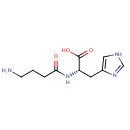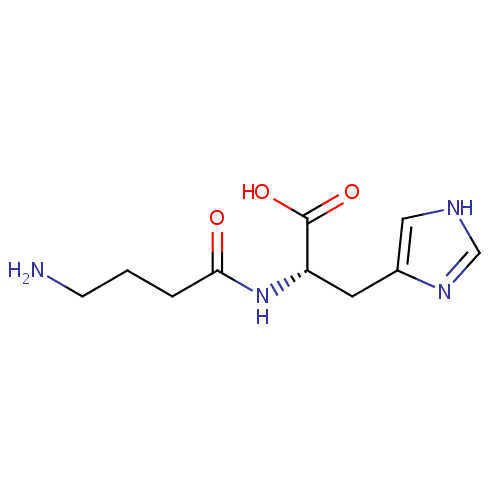| References: |
- Iurovskii SL, Orlov VI, Pogorelova TN, Drukker NA, Madan M: [Homocarnosine of the amniotic fluid as an indicator of fetal cerebral lesions] Akush Ginekol (Mosk). 1989 Sep;(9):45-7. Pubmed: 2596637
- Kanehisa, M., Goto, S., Sato, Y., Furumichi, M., Tanabe, M. (2012). "KEGG for integration and interpretation of large-scale molecular data sets." Nucleic Acids Res 40:D109-D114. Pubmed: 22080510
- Lenney JF, Peppers SC, Kucera CM, Sjaastad O: Homocarnosinosis: lack of serum carnosinase is the defect probably responsible for elevated brain and CSF homocarnosine. Clin Chim Acta. 1983 Aug 15;132(2):157-65. Pubmed: 6616870
- Lunde HA, Gjessing LR, Sjaastad O: Homocarnosinosis: influence of dietary restriction of histidine. Neurochem Res. 1986 Jun;11(6):825-38. Pubmed: 3736769
- Manyam BV, Bhatt MH, Moore WD, Devleschoward AB, Anderson DR, Calne DB: Bilateral striopallidodentate calcinosis: cerebrospinal fluid, imaging, and electrophysiological studies. Ann Neurol. 1992 Apr;31(4):379-84. Pubmed: 1586138
- Menachem EB, Persson LI, Schechter PJ, Haegele KD, Huebert N, Hardenberg J, Dahlgren L, Mumford JP: Effects of single doses of vigabatrin on CSF concentrations of GABA, homocarnosine, homovanillic acid and 5-hydroxyindoleacetic acid in patients with complex partial epilepsy. Epilepsy Res. 1988 Mar-Apr;2(2):96-101. Pubmed: 3143561
- Pearl PL, Novotny EJ, Acosta MT, Jakobs C, Gibson KM: Succinic semialdehyde dehydrogenase deficiency in children and adults. Ann Neurol. 2003;54 Suppl 6:S73-80. Pubmed: 12891657
- Perry TL, Kish SJ, Sjaastad O, Gjessing LR, Nesbakken R, Schrader H, Loken AC: Homocarnosinosis: increased content of homocarnosine and deficiency of homocarnosinase in brain. J Neurochem. 1979 Jun;32(6):1637-40. Pubmed: 448356
- Petroff OA, Hyder F, Mattson RH, Rothman DL: Topiramate increases brain GABA, homocarnosine, and pyrrolidinone in patients with epilepsy. Neurology. 1999 Feb;52(3):473-8. Pubmed: 10025774
- Petroff OA, Mattson RH, Behar KL, Hyder F, Rothman DL: Vigabatrin increases human brain homocarnosine and improves seizure control. Ann Neurol. 1998 Dec;44(6):948-52. Pubmed: 9851440
- Promyslov MSh, Mirzoian RA: [Homocarnosine metabolism in brain tissue] Vopr Biokhim Mozga. 1976;11:71-7. Pubmed: 1032224
- Promyslov MSh, Mirzoian RA: [Study of homocarnosine metabolism in the brain tissue in diseases of the nervous system] Vopr Med Khim. 1976 Mar-Apr;22(2):209-12. Pubmed: 1025883
- Rothman DL, Behar KL, Prichard JW, Petroff OA: Homocarnosine and the measurement of neuronal pH in patients with epilepsy. Magn Reson Med. 1997 Dec;38(6):924-9. Pubmed: 9402193
- Sjaastad O, Berstad J, Gjesdahl P, Gjessing L: Homocarnosinosis. 2. A familial metabolic disorder associated with spastic paraplegia, progressive mental deficiency, and retinal pigmentation. Acta Neurol Scand. 1976 Apr;53(4):275-90. Pubmed: 1266573
- Sjaastad O, Gjessing L, Berstad JR, Gjesdahl P: Homocarnosinosis. 3. Spinal fluid amino acids in familial spastic paraplegia. Acta Neurol Scand. 1977 Feb;55(2):158-62. Pubmed: 842287
- Sreekumar A, Poisson LM, Rajendiran TM, Khan AP, Cao Q, Yu J, Laxman B, Mehra R, Lonigro RJ, Li Y, Nyati MK, Ahsan A, Kalyana-Sundaram S, Han B, Cao X, Byun J, Omenn GS, Ghosh D, Pennathur S, Alexander DC, Berger A, Shuster JR, Wei JT, Varambally S, Beecher C, Chinnaiyan AM: Metabolomic profiles delineate potential role for sarcosine in prostate cancer progression. Nature. 2009 Feb 12;457(7231):910-4. Pubmed: 19212411
- Tell G, Bohlen P, Schechter PJ, Koch-Weser J, Agid Y, Bonnet AM, Coquillat G, Chazot G, Fischer C: Treatment of Huntington disease with gamma-acetylenic GABA an irreversible inhibitor of GABA-transaminase: increased CSF GABA and homocarnosine without clinical amelioration. Neurology. 1981 Feb;31(2):207-11. Pubmed: 6258106
|
|---|


